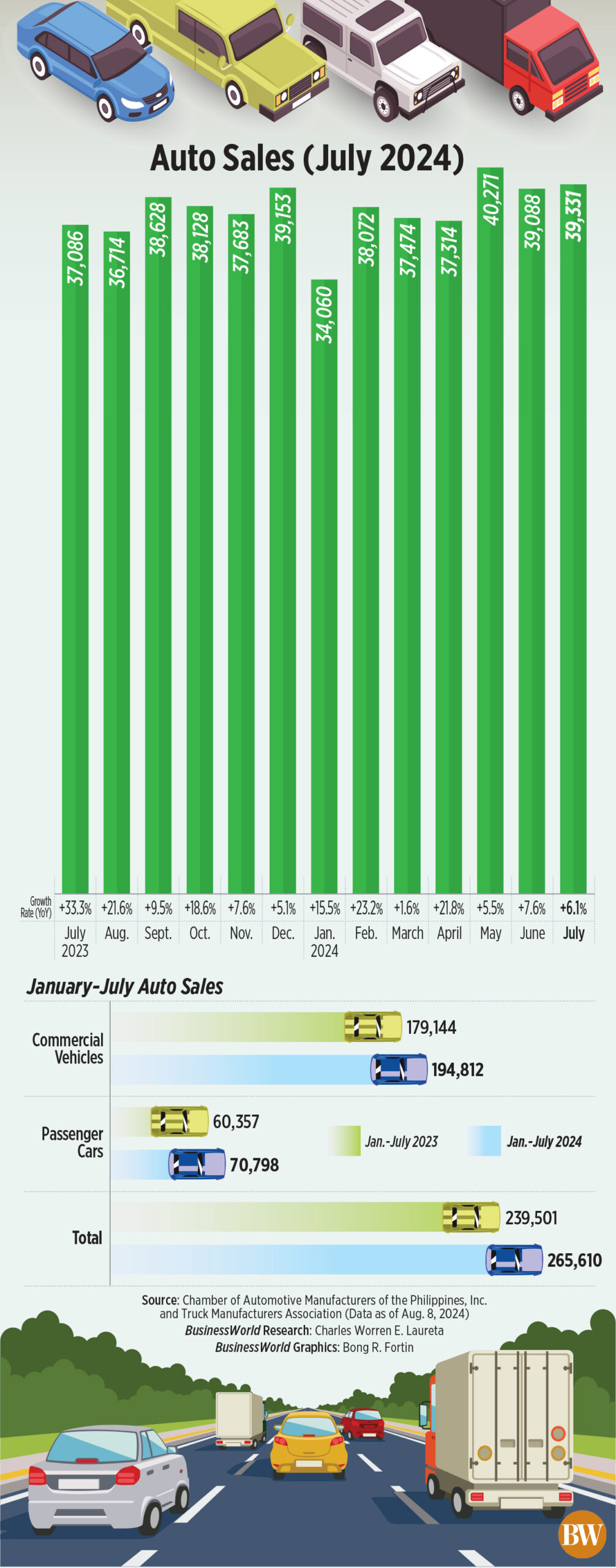By Justine Irish D. Tabile, Reporter
VEHICLE SALES in the Philippines jumped by an annual 6.1% in July, driven by new launches and supply availability, according to an industry report.
A joint report by the Chamber of Automotive Manufacturers of the Philippines, Inc. (CAMPI) and the Truck Manufacturers Association (TMA) showed vehicle sales rose to 39,331 units in July from 37,086 units in the same month last year.
Month on month, car sales inched up by 0.6% from the 39,088 units sold in June.
 “New product launches, improved product offerings, good sales momentum, as well as supply availability helped neutralize the impact of Typhoon Carina, especially towards the latter part of July,” CAMPI President Rommel R. Gutierrez said in a statement.
“New product launches, improved product offerings, good sales momentum, as well as supply availability helped neutralize the impact of Typhoon Carina, especially towards the latter part of July,” CAMPI President Rommel R. Gutierrez said in a statement.
In July, passenger car sales increased by 14.9% to 10,923 units from 9,509 units sold a year ago. Month on month, passenger car sales edged up by 2.78%.
Sales of commercial vehicles, which accounted for 72.23% of the industry’s total sales, went up by 3% year on year to 28,408 units. Month on month, commercial vehicles sales dipped by 0.2%.
Broken down, light commercial vehicle sales slipped by 3.6% year on year to 20,849 units, while sales of Asian utility vehicles (AUV) jumped by 32.7% to 6,620 units.
Sales of medium trucks slid by 23.9% to 299, while sales of heavy trucks slumped by 35.6% to 65. Light-duty truck and bus sales went up by 23.4% to 575 units.
For the first seven months of the year, vehicle sales went up by 10.9% to 265,610 units from 239,501 units a year ago.
Passenger car sales jumped by 17.3% to 70,798 units, while commercial vehicle sales increased by 8.7% to 194,812 units.
Rizal Commercial Banking Corp. Chief Economist Michael L. Ricafort said the latest vehicle sales data were “decent.”
“However, although the vehicle sales growth from January to July is still higher than GDP (gross domestic product) growth, the vehicle sales growth is starting to normalize after double-digit growth rates in recent months and coming from a higher base as a result,” Mr. Ricafort told BusinessWorld via Viber.
In the first half, GDP growth averaged 6%, still on track to meet the government’s full-year target of 6-7%.
Mr. Ricafort said the steady car sales reflect the country’s favorable demographics, as the majority of the population is of working age.
“Local vehicle sales and production growth rates at double-digit levels in recent months are still leading indicators of the further growth and recovery of the Philippine economy,” he said.
Toyota Motor Philippines Corp. remained the market leader with sales of 122,730 units in the January-to-July period, up by 11.47% from 110,158 units a year ago. Toyota sales accounted for 46.21% of the market.
Mitsubishi Motors Philippines Corp. ranked second with a market share of 19.05%. Mitsubishi sales jumped by 15.4% to 50,599 units in the first seven months from 43,831 units last year.
In third spot was Ford Motor Co. Phils. Inc. with a market share of 6.33%. Ford’s sales went up by 1.2% to 16,817 units.
Rounding out the top five were Nissan Philippines, Inc., whose sales inched up by 0.9% to 15,819, while Suzuki Phils., Inc. posted a 13% rise in sales to 11,499 units.
This year, CAMPI set a sales target of 468,300 units, up 9% from the 429,807 units sold in 2023.
The 265,610 units sold in the January-to-July period already accounted for 56.7% of the industry’s target for the year.

